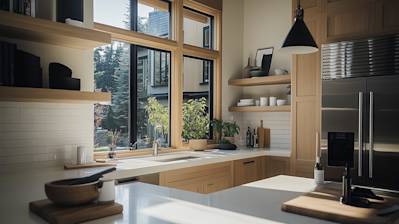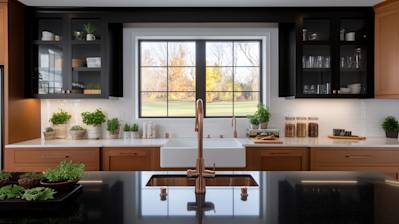If you are in the market for a touchless kitchen faucet, this blog post will serve as an excellent guide to help you make an informed decision. Here, we will delve deep into the world of touchless kitchen faucets and highlight the newest technology in faucets, its benefits, the different types, and what to look for while buying one. We will examine why touchless is outperforming the traditional faucet methods, and why they are now being considered as the future of kitchen appliances. So, let's get started on this journey to understand the ins and outs of touchless kitchen faucets.
An Introduction to Touchless Kitchen Faucets
A touchless kitchen faucet utilizes motion sensor technology that allows you to start the flow of water without touching the faucet. Instead, just place your hands under the spout to activate the water flow. This hands-free operation is hygienic, convenient, and efficient – hence, increasingly becoming a popular choice in homes and businesses.
Benefits of Touchless Kitchen Faucets
Wondering why choose a touchless kitchen faucet over the traditional ones? Here are some compelling reasons:
- Hygienic and germ-free: Since there’s no need to touch the faucet, it helps lower the spread of germs and keeps your sink area clean.
- Water conservation: These faucets run only when activated, thereby reducing water waste.
- Convenience: They are particularly helpful when your hands are dirty, or you have both hands full.
Understanding the Different Types of Touchless Kitchen Faucets
Now that you know why touchless kitchen faucets are a fantastic choice, let's delve deeper into the different types available in the market:
Pull Down Touchless Faucets
This model allows you to pull down the faucet's wand towards the sink. Known for their versatility, they are perfect for washing large pots and pans or cleaning the sink.
Pull Out Touchless Faucets
Pull-out faucets have a head that pulls out towards you, making it a great tool for washing fruits or cleaning up the countertop.
Bar Touchless Faucets
Ideal for small sinks, these faucets are compact and convenient to use, delivering the same touchless features in a smaller package.
Key Features to Consider When Buying a Touchless Kitchen Faucet
When it comes to investing in a touchless kitchen faucet, there are several key features that you should consider:
- Sensor quality: A high-quality sensor will ensure reliable activation and deactivation of water flow.
- Power source: Some models are battery-powered, while others require an electrical connection.
- Finish: Look for durable finishes like chrome or stainless steel that are easy to clean and resist fingerprints.
- Water flow: Always check the water flow rate. A higher flow rate will fill up pots more quickly, while a lower flow rate will be more efficient.
- Design: The faucet should be well-suited to your kitchen's aesthetic and functionality.
A brief about Top Brands Offering Touchless Kitchen Faucets
There are several renowned brands in the market which produce high-quality touchless kitchen faucets. Some of them include Moen, Kohler, and Delta, among others. Each brand has its unique features, and before you make a purchase, it’s ideal to compare these to find the one that suits your needs the best.
Investing in a touchless kitchen faucet is a smart move towards a more efficient and hygienic kitchen. They not only enhance the functionality of your kitchen but also add a touch of modern sophistication to it. Whether you are renovating your space or merely replacing an old faucet, a touchless faucet's investment will be worth every penny. So, hop on this trend of touchless kitchen faucets and step into the future of kitchen appliances today!
Frequently Asked Questions About Touchless Kitchen Faucets
How do touchless kitchen faucets work?
Touchless kitchen faucets use sensor technology. When the sensor detects the movement of your hand or a utensil, it signals the faucet to start or stop the flow of water. This technology helps reduce water waste and increases the faucet's usability particularly when your hands are full or dirty.
Can I adjust the temperature on a touchless kitchen faucet?
Yes, you can adjust the temperature on most touchless kitchen faucets. They typically feature a lever or dial which can be set to your preferred temperature. However, keep in mind that models vary and some may not provide this option.
Do touchless kitchen faucets need electricity to operate?
Touchless kitchen faucets are usually powered by batteries or an AC power adaptor plugged into an outlet under the sink. Others may use a combination of both for redundancy. Remember to check the power source before purchasing, and ensure that it suits your kitchen setup.
How long do batteries last in a touchless kitchen faucet?
The battery lifespan in a touchless kitchen faucet varies based on the model and frequency of use. However, on average, the batteries should last around 1 to 2 years. Many faucets also feature light indicators when it is time to change the batteries.
Are touchless kitchen faucets hard to install?
The installation process for touchless kitchen faucets is not significantly different from regular faucets. However, they may involve a few additional steps due to the sensor and power source components. You may want to hire a professional if you aren't confident with DIY installation, but many homeowners find the process straightforward with the instruction manual.
What happens if the sensor on a touchless kitchen faucet stops working?
If the sensor on your touchless kitchen faucet stops working, contact your faucet's manufacturer or a professional plumber. The sensor might need replacing or there could be an issue with the power source.
Will a touchless kitchen faucet turn on accidentally?
Most touchless kitchen faucets are designed to minimize accidental activation. They use infrared sensor technology which is only activated by motion within a certain proximity. However, moving objects very close to the faucet could activate the sensor.
Do touchless kitchen faucets have a manual override?
Most touchless kitchen faucets feature a manual override. This means you can still use the faucet conventionally when desired or if there are issues with the sensor. This function is usually operated by a lever or handle on the body of the faucet.
Can you disable the touchless feature on a touchless kitchen faucet?
Yes, it is possible to disable the touchless feature on most touchless kitchen faucets. The process for disabling this feature varies between models, so you'll need to refer to the instruction manual for your specific model.
Are touchless kitchen faucets worth the investment?
Whether a touchless kitchen faucet is worth the investment depends on your needs and priorities. They offer convenience, help conserve water, and can contribute to improved hygiene by minimizing contact with the faucet. However, they can be more expensive than conventional faucets and may require battery replacements or access to a power outlet under the sink. Consider these factors carefully to decide if a touchless kitchen faucet is right for you.
Pros and Cons of Touchless Kitchen Faucets
Pros of Using Touchless Kitchen Faucets
Superior Hygiene
One of the biggest benefits of having a touchless kitchen faucet is the enhanced hygiene it provides. Since there's no need to physically handle the faucet, the risk of contamination from germs and bacteria is significantly reduced.
Water Conservation
Touchless kitchen faucets are excellent for water conservation. They are designed to turn off automatically when not in use, therefore reducing unnecessary water wastage. This makes them a cost-effective and environmentally friendly addition to any kitchen.
Convenience and Accessibility
Touchless kitchen faucets offer unparalleled convenience. Whether your hands are full, dirty, or busy, you can easily activate the water flow with a single movement. This makes them particularly useful for people with mobility difficulties or for children who struggle to reach traditional faucets.
Modern Aesthetic
Touchless kitchen faucets often feature sleek and modern designs that can enhance the aesthetic appeal of your kitchen. They come in a variety of styles and finishes to match any decor and can bring a touch of elegance and sophistication to your space.
Easy to Install and Maintain
Most touchless kitchen faucets are designed to be easy to install. Many models are equipped with an easy-to-follow installation guide and require basic plumbing skills. They are also generally easy to clean and maintain.
- They have fewer parts that can wear out or get damaged.
- Many have self-cleaning features.
- Their finishes are generally resistant to tarnishing, rust, and corrosion.
Cons of Using Touchless Kitchen Faucets
High Initial Cost
One of the most significant disadvantages of touchless kitchen faucets is their high initial price. Though they can save money over time by reducing water wastage, the upfront cost may be prohibitive for some homeowners.
Battery Life
Most touchless kitchen faucet models operate on batteries. Consequently, when the batteries run out, the faucet defaults to manual operation or may not function at all. Some may view the need for constant battery replacement as a drawback.
Potential for Accidental Activation
There’s the risk that the sensor could mistake a passing movement as an activation attempt, leading to unnecessary water flow. While this isn't a common issue, it does happen, particularly when the sensor's sensitivity is set to high.
Complex Technology
Due to their technological nature, touchless kitchen faucets might experience technical issues from time to time. These could range from sensor failure to issues with the internal water control mechanism. While these issues are generally repairable, the need for repairs will add to the total cost of owning the faucet.
Limited Flow Duration
Since touchless faucets are designed for short-term use, the water flow is automatically cut off after a certain period. While this feature prevents flooding and wastage, it may be inconvenient for tasks that require a steady and prolonged flow.
Summary
A touchless kitchen faucet is more than just a stylish addition to your kitchen. Its smart and innovative design makes hand washing, cooking, and cleaning tasks in your kitchen a breeze. Reducing water waste and preventing the spread of germs, it delivers an unparalleled level of convenience and hygiene.
With a touchless kitchen faucet, expect to see a significant decrease in your water usage. This automated innovation can sense when an object is near and runs water only when necessary, avoiding any wastage. Plus, its touchless feature takes us one step closer to a technological future while keeping health and hygiene at the forefront.
Last but not least, a touchless kitchen faucet is a great investment, offering a cleaner, safer and more efficient kitchen experience. Whether you're a seasoned chef or a novice home cook, this device will make your culinary adventures easier and more enjoyable. So, for a hassle-free kitchen aid that combines utility, convenience, and style, the touchless kitchen faucet is a clear winner.
About KYPD Plumbing
Welcome to KYPD Plumbing, your premier destination for professional plumbing needs in Nicholasville, KY. We are proud of our accomplished reputation as reliable, skilled, and customer-focused professionals. Our team is versed to cater to a broad spectrum of plumbing issues, providing 24/7 emergency services. We understand that plumbing problems can be a real headache, which is why at KYPD Plumbing, we strive to offer solutions that are not only efficient but are affordable and long-lasting. For more information, check us out at our official site here.
Tags: kitchen renovation, smart home technology, modern kitchen design,














